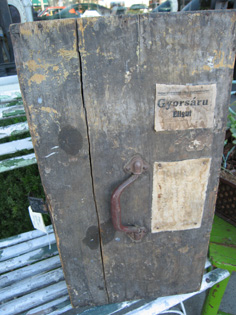
You may remember, a few months ago, I posted about the house at Filoli
here, with the promise to post about the gardens soon. Well, I’ll admit I’m a bit slow sometimes, but I
do keep my promises in the end. This past week, I got to go home to the San Francisco Bay Area and visit with my sister and made it a point to visit Filoli again to see what was blooming in the gardens this summer.
Above is the massive entry way with it’s stunning gothic lantern. Be sure to notice the carved detail in the ceiling overhead. As spectacular as the house is itself, the interiors pale in comparison to the landscape and gardens in my opinion. The plantings and displays change every season. In the nearly thirty years I’ve been visiting the estate, I’ve never once seen the same place twice. It is truly remarkable the amount of talent and hard work that the volunteers and staff put into keeping the home and gardens as magnificent as they always are.

Just outside of the front entrance they have recently erected a temporary dovecote covered in succulents and topped with a thatch roof. Robin Stockwell, owner of
Succulent Gardens in Castroville, California, designed and planted the vertical panels covering the walls of the dovecote and loaned them to Filoli.
Filoli staff Lucy and Jonathan Tolmach designed the dovecote which was built by Filoli's woodworker, Paul Feichter. The succulents in the dry wall, the containers and the thatch shingles were grown by Filoli greenhouse staff. The design of the structure was inspired by an original aviary in the greenhouse courtyard, which housed the Bourns’ parrots. Dovecotes made today are ornamental garden features, but historically dovecotes were functional and designed to raise pigeons for squab. The word dovecote refers to the dove's cottage and is pronounced “dove cot” in England. The roof of the dovecote is covered in thatch like shingles made from flats of straw seeded with perennial rye.

The succulents were grouped and selected for contrasting foliage effects. They were planted in plastic panels which are designed for making vertical walls. The panels are watered from above with a drip irrigation system, which drips water from one panel to the next taking about 100 minutes to completely soak all five vertical panels. The succulents are watered every 7 to 10 days.
 Hi there!
Hi there!Filoli’s new dovecote houses three mated pairs of pigeons rescued by volunteers of the MickaBoo Dove and Pigeon Rescue, a division of
Mickaboo Companion Bird Rescue in San Jose. These pigeons, found abandoned on the streets of San Francisco and San Jose, are named June Bug and Bandit, Squeak and Sesame, and Angel and Bo.
Exiting the house, you enter the sunken garden. This is the most formal area of the garden and the floral displays are always spectacular. This was the way we found it today….

The peach colored flowers are stock.

Notice the potted containers leading up the steps, this is a design element you’ll see over and over again in the gardens. I love it!

A different season, a different year; the garden is equally beautiful. The fog rolling over the hills beyond makes a beautiful backdrop for the blue and yellow of the plantings.

This time the parterre’s are filled with blue-maybe salvia? See the pots lining the steps? Tulips are a perennial favorite at Filoli.

The clock tower atop the former carriage house, now garden shop is the only reminder of times’ passage as you stroll through this lovely setting.

Springtime in all of it’s glory. The color selections each year are clearly made by a very well educated eye.

Adjacent to the sunken garden is the delightful garden pavilion. Reminiscent of an orangerie, a garden pavilion was a building frequently found on the grounds of fashionable residences on the east coast of America during the 18th and 19th centuries. Similar to a summerhouse or a conservatory, the garden pavilion was a symbol of prestige and wealth.

Filoli's garden pavilion was designed to make a break in the long brick wall enclosing the walled garden and to match the architecture of the main house. It has eight stone figureheads at the top of the French-style windows.

The interior floor of the garden pavilion is composed of large Tavernelle marble, separating bands of black and gold marble and small squares of Belgian black marble. The wainscoting (or splash panel) around the walls is beige Tavernelle marble. The tabletop is brecciate violet Brocatelle marble. The Bourns used the table in their San Francisco home.
The elaborate wall sconces were originally intended for the staircase area in the house.

A pair of lovely white doves greet visitors in the summer months.

Filoli was designed to include many of the elements you would expect on an English country estate. In addition to a formal garden, plenty of space was allocated for a large working kitchen garden with espaliered fruits, berry cages, vegetable garden, cutting garden and greenhouses.

Summer paths lined with lavender.

Utterly impossible to resist running my hand through as we travelled up the path.

A row of corn-- the knot garden beyond.

Knot gardens were commonly designed to display royal coats
of arms, figures of plants or animals, or stitches of embroidery, and the interstices would be
filled with colored sand and earth (open knot, as at Filoli) or with flowers (closed knot).
While knot gardens are traditionally composed of flat hedges, Filoli’s has a different look;
hedges are shorn and sculpted into three-dimensional under- and overlapping woven
strands, making their maintenance more challenging, but also creating a beautiful, intricate,
undulating effect.
The shrub that contributes the exquisite maroon color to Filoli’s knot garden is a cultivar of Japanese barberry, Berberis thunbergii ‘Crimson Pigmy.’ The Japanese Barberry’s dark leaves contrast beautifully with the grey and green foliage of the other plants.

In 1991, Mrs. Duncan Low, a garden volunteer had the idea to create miniature versions of the original knots. Filoli’s maintenance staff built two 36” square boxes and engraved the sides to represent the brick pattern of the garden’s walls. Each box took four hours to plant, with dwarf hedges spaced at one inch on center. The lead
horticulturist of the panel gardens keeps an eye on the water needs of these plants, and volunteers are in charge of their weekly pruning with bonsai shears.

One of many iron gates in the walled gardens. Each one boasting a beautiful view beyond.

Spires of acanthus practically sparkling in the sunlight--recommended by English gardening authorities of the period as an excellent foundation plant and in entry courtyards for bold and architectural effect in scale with large residences and has low maintenance requirements. These were grown by Romans in villa gardens.

A stunning pink tree rhododendron under the cool canopy of the hundreds-of-years-old trees above.

More parterres--filled with simple pink begonias.
A visit last Autumn finds a garden asleep--storing energy for it’s spring spectacle.

An important element to the formal garden is the presence of the evergreen, Irish yews, which permeate the space creating strong, vertical lines. These compliment the formal design and serve to guide the viewer’s eye to important features.

A view of the back of the house~visible here are 8 of the house’s 17 chimneys.

A back door with potted flaming tulips lining the steps.

Another door boasts delicate pink tulips.

The estate has many of these stone planters and statuary pieces--a wonderful way to add architecture to any garden, large or small.

A show-stopping Agave plant adds it’s own brand of architecture. I loved this planting so much, the first time I saw it, I came right home and planted my own Agave pot. Hopefully, someday, it will grow to be as jaw-dropping as the one here.

Succulents in a cement basin~does it get any better than this?
Several of the garden gates are topped by these stone cartouches.

Amazing ironwork--craftsmanship not often seen today.

There is so much more to see and each time I visit I see and learn something new. It is such a wonderful source of inspiration. Filoli offers many educational programs for gardeners and their website is a virtual wealth of information. To learn more about this magnificent estate and all that it has to offer, visit them at
www.filoli.org. To see the post I did on the house, click
here.
I hope you enjoyed your tour of the gardens at Filoli, I know I did!





























































































